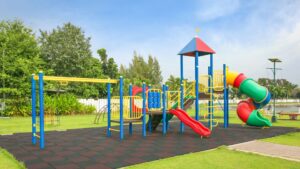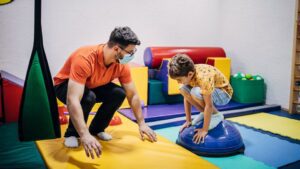Starting an indoor playground business can be a rewarding venture, but the high upfront costs often stop many aspiring entrepreneurs. Renting a location, buying playground equipment, and setting up operations usually require substantial investment. But here’s the good news: with creativity, strategy, and resourcefulness, you can start an indoor playground business with little to no money.
This guide walks you through every step—from research and planning to finding funding, reducing costs, and building community support—so you can launch your dream business without breaking the bank.

1. Create a Detailed Indoor Playground Business Plan
A well-thought-out business plan is your first step to success, especially when you have limited funds. It doesn’t just guide your decisions—it also convinces investors, partners, and grant providers that your idea is worth supporting.
👉 Need help? Check out our detailed guide on How to Write a Profitable Business Plan.
Market Research
- Conduct surveys or interviews with parents to understand their needs. 👉 Learn more in our post on How to Do Effective Market Research.
- Check if your area lacks safe indoor play areas for children.
- Identify your target customers—families, schools, daycare centers, or community groups.
Competitive Analysis
- Visit existing playgrounds to see what works and what doesn’t.
- Analyze competitors’ pricing, operating hours, facilities, and customer reviews.
- Look for gaps in the market, such as eco-friendly play equipment or parent-focused amenities.
Budget & Financial Planning
- List startup costs: equipment, rent, licenses, insurance, and marketing.
- List operational costs: staff salaries, utilities, maintenance, and cleaning.
- Forecast how many customers you’ll need per day/week to break even.
👉 Also read: Why Your Website Has No Traffic and How to Fix It — useful for budgeting your marketing strategy.

2. Find Partners or Investors
If you don’t have money to invest, consider bringing in people who do.
👉 For more inspiration, check out our article on Smart Startup Financing Options.
Business Plan Presentation
Show potential investors your profit projections, safety protocols, and marketing strategy. Highlight how your playground stands out.
Where to Find Investors
- LinkedIn: Join local business groups.
- Angel networks & incubators: Pitch your idea to small business investors.
- Family & friends: Sometimes your immediate network is your first investor pool.
Partnerships
Team up with individuals or businesses who share your vision. For example:
- A café owner who wants to attract families.
- An education center that needs a recreational space for kids.

3. Utilize Crowdfunding Platforms
Crowdfunding is one of the most popular ways to raise startup money without loans.
👉 Want more creative funding ideas? See our guide: How to Raise Funds for Your Startup.
Steps to Launch a Crowdfunding Campaign
- Choose the right platform: Kickstarter, Indiegogo, or local alternatives.
- Create a story-driven page: Share your vision, benefits for kids, and your community impact.
- Offer rewards: Examples include:
- Discounted entry passes.
- Membership cards.
- Exclusive first-access events.
4. Seek Government and Local Grants
Many regions offer small business grants or low-interest loans for startups that serve the community.
👉 For tips, explore our article: Government Grants and Loans for Small Businesses.
Steps:
- Research local government websites, small business administrations, or nonprofit organizations.
- Apply with supporting documents: business plan, financial forecast, and market analysis.
- Highlight the community benefit (safe space for kids, family bonding, educational activities).
5. Rent or Share Existing Spaces
Leasing a commercial property may be costly, but there are cheaper alternatives.
👉 Related reading: How to Build Local Partnerships for Business Growth.
- Community Centers or Schools: Rent gymnasiums or multipurpose rooms during off-hours.
- Vacant Spaces: Contact landlords of empty stores—some may offer low rent just to have occupancy.
- Shared Spaces: Partner with cafés, daycare centers, or fitness studios to co-share rental expenses.
6. Start in Phases
Don’t try to launch the biggest playground at once. Instead, build gradually.
- Phase 1: Start with a small soft-play area or mobile play equipment.
- Phase 2: Add more attractions such as ball pits, slides, and climbing walls.
- Phase 3: Expand into birthday party services, workshops, and special events.
👉 Learn more about staged growth in our post on The Lean Startup Method Explained.
7. Utilize Resources to Optimize Costs
When starting without money, you must cut unnecessary expenses.
- Buy second-hand equipment: Check online marketplaces, auctions, or other closing playground businesses.
- DIY equipment: Build safe, simple play structures if you have carpentry or crafting skills.
- Low-cost marketing: Use free tools like social media, word-of-mouth, and local community boards.
👉 Pro tip: Strengthen your online reach with our guide on Link-Building Strategies for SEO.
8. Gain Community Support
Your community can be your biggest resource.
- Recruit Volunteers: Use social media or local events to find parents and youth groups who want to help.
- Host Community Events: Organize family days, kids’ crafts, or educational workshops to build awareness.
- Engage Local Influencers: Partner with parent bloggers or community leaders for promotion.
👉 Learn how collaboration boosts visibility: Partnership Marketing for Small Businesses.
9. Establish Strategic Partnerships
Collaboration opens more doors.
- Schools & Kindergartens: Offer discounted trial visits or field trips.
- Local Businesses: Provide sponsorship packages where companies can advertise inside your playground in exchange for funding support.
- Birthday Party Providers: Partner with bakers, photographers, or entertainers to create full-service packages.
10. Stay Flexible and Innovative
Markets change—your business should adapt too.
- Adjust prices based on demand.
- Rotate activities to keep kids engaged.
- Add seasonal themes (Halloween, Christmas, summer camps).
- Offer loyalty cards or memberships for returning families.
👉 For more marketing tactics, read: Business Growth Blog.
Final Thoughts
Starting an indoor playground business with no money is challenging but not impossible. With the right planning, partnerships, creativity, and community support, you can build a thriving business step by step.
👉 Looking for more low-cost startup ideas? Explore our Business Growth Blog for strategies that work.




